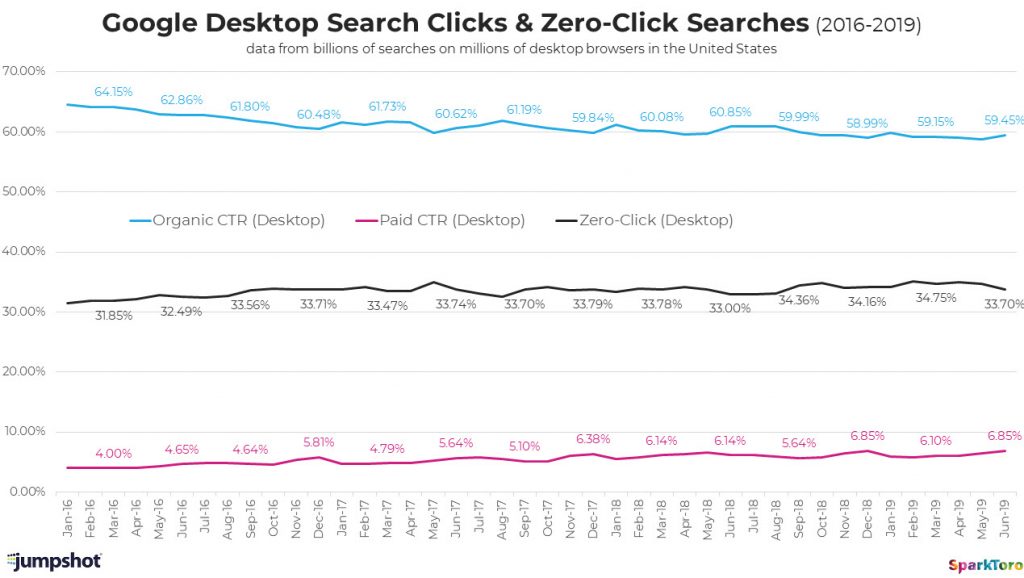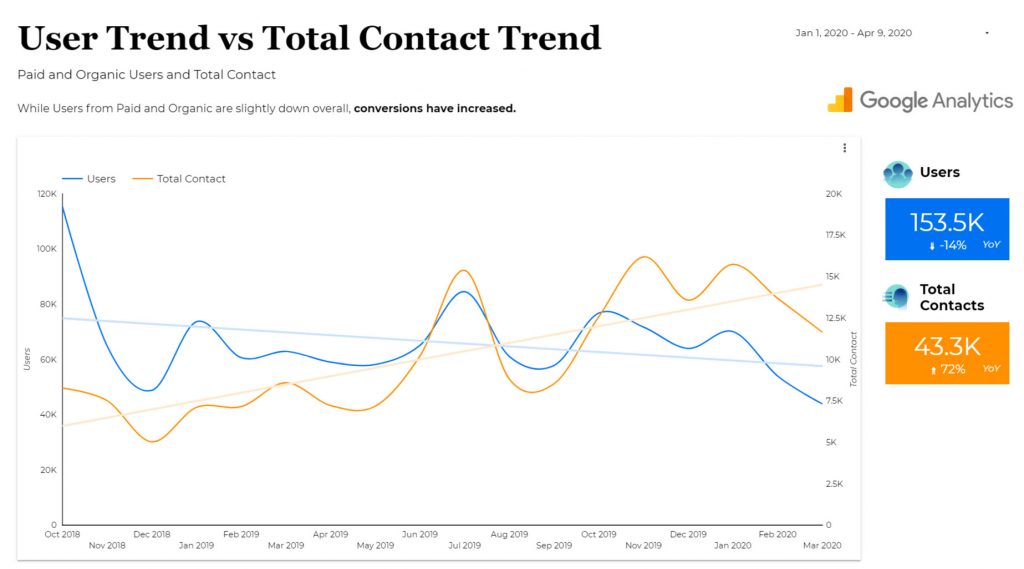In June of 2019, there was a fundamental shift in the way Google SERPs operate, which had been in motion for some years beforehand. For the first time, the majority of searches on Google resulted in a paid search click, or no click at all. In other words, search results that facilitated an organic click through to a website were in the minority.
As Rand Fishkin outlines in his widely-shared analysis of this shift, the implication is that Google is prioritizing Google. It’s building ways to keep people within the SERP, and prioritizes paid search results when it can’t, so they have a higher chance of getting monetary value from the click-through.

An early sign of this shift was when Google introduced “position zero.” By pulling information and content from other websites and highlighting it directly in the Google SERP, it reduced the need for people to click through to any given website. When people do a Google search, get their information from the SERP, and do not click through to a website, this is what is known as a “zero-click” search.
Here is what you can expect as a result of this shift, and what trends to look for in your digital marketing reports. I also highly recommend reading Portent Senior SEO Strategist Evan Hall’s explanation of zero-click as a primer to this post.
Symptoms of Zero-Click
To set the stage, it’s important to remember that because this shift has happened within the Google SERPs, it will primarily affect two channels: organic search and paid search.
It’s also important to keep in mind that what you experience may vary depending on your activity within these two channels; these reporting observations are not one-size-fits-all. You may see variations of how these metrics have been impacted depending on the number of visitors to your website, your participation in either of these channels, and your industry.
Organic Search
A big symptom of the zero-click phenomenon is a gradual decrease in organic traffic to your website. This is measurable in both Google Analytics and Google Search Console, represented as users in GA, and clicks from Search Console.

Your visibility on the Google SERPs (i.e., impressions) has likely remained steady or has even improved. If you’re optimizing your website for Google rankings, you will continue to rank well, and still appear high on the SERPs. Your organic search impressions are likely not impacted.
If that is the case, Google may have recognized that your website is ranking well and is relevant to users, and may tap your website for SERP “position zero” content. Alternatively, they could be surfacing “position zero” information from related businesses, or even your competitors, and people do not need to click through to a website.
From a usability perspective, it saves users a click if Google can scrape information that they are searching for. However, from a website reporting perspective, there will be a downward trend of organic users who visit your website.

As a result, impressions remain similar or have even improved, depending on the level of your SEO work, and your organic users have slowly declined.
Paid Search
After zero-click searches, paid search results have been increasingly prioritized to come after the position zero answer boxes. It is beneficial for Google to prioritize paid search to maximize clicks that result in revenue.

Although the budget drives Google Ads, and rankings may vary depending on the effectiveness of your strategy, if Google is beginning to prioritize paid search rankings, they may show higher in the SERPs.
We’ve seen this phenomenon reflected in client data where clicks increase at a higher rate than both impressions and cost. With a relatively consistent YoY budget, and no major optimizations or campaign restructures, we can attribute this click increase in part to SERP result behavior.

Metrics You Can Measure
With these changes in the SERP in mind, following are several metrics to help you gauge the impact of zero-click on your reporting, and on your digital strategy.
“Off-Site” Metrics
The following are metrics you can measure in the Google SERP with Google programs and third-party marketing tools. These will help you identify SERP trends for your own business outside of your website data.
Google Ads
Impressions and Clicks. As we have illustrated with client data, look to see if the number of “clicks” from paid search ads has increased over time, and at a faster rate than impressions or budget increases. This implies that the CTR is increasing, and people are clicking through paid ads at a higher rate.
Phone Calls. Google Ads recently added a reporting metric that allows you to track phone calls placed from a paid search call extension. This is another opportunity for a user to forgo a click and interact with your brand directly.

Google Search Console
Impressions and Clicks. Similar to Google Ads, if you’re optimizing your website to rank well on Google, your organic impressions should have a similar YoY trend, depending on the seasonality of your business. With Google placing “position zero” boxes in the SERPs, your organic click-through rate may have gone down. Both metrics are important to monitor as you evaluate the impact on your organic traffic.
Google My Business
Phone Calls and Directions. Google has highlighted the visibility of local businesses in the SERP with Google My Business profiles. To measure whether your off-site activity has increased, monitor the number of people who request directions to your business, or call you directly from your Google listing.

STAT
Keywords Ranking in Position Zero. STAT is an SEO-focused tool that helps evaluate your rankings on the Google SERP. With this tool, you can define which keywords you want to track data for, and how they appear in the SERP. The most common types of ways a keyword can show in position zero are:
- Featured Snippets
- Knowledge Graphs
- Answer Boxes
By creating a dynamic tag in STAT, you can aggregate the keywords showing for any of the above SERP features, and have a clear idea of which keywords, and how many, rank in position zero. If you compare this value against the number of searches for those keywords, you can get an idea of the percentage of searches your tracked keywords are ranking for.

On-Site Metrics
These metrics are all measured through Google Analytics based on your website data. After getting an off-site idea of how your business appears in the SERPs, it’s valuable to measure user activity down the marketing funnel to determine the impact on your conversion and sales metrics.
Google Analytics
Paid Search Visitors. As you’re tracking the increase of clicks in your paid search activities from Google Ads, there should be a corresponding increase in paid search visitors to your site. There will always be some discrepancy between the values. However, they should be in the same ballpark. You should take note if there is a large difference between Google Ads clicks and Google Analytics users and sessions from Google Ads. This could indicate a separate tracking issue or functionality problems with the paid search landing pages.
Organic Search Visitors. Similar to paid search, there should be a ballpark similarity between organic clicks from Search Console, and organic users in Google Analytics. You can also expect them to trend in similar directions, so if your overall Search Console organic clicks have been decreasing, organic search visitors in GA should follow suit.
Your Primary Web Conversions. Be sure to monitor your website conversions (purchases, form fills, etc.) and compare them against internal leads and sales. Has there been a major shift? With client data, we have seen that despite the overall drop in visitor traffic to a website, the conversion rates have actually improved. Despite a seemingly scary impact of zero-click reducing organic searches, we have also seen that it can improve and optimize the user journey. Although fewer people are arriving at your website, the users who do tend to be more qualified.

Has Zero-Click Impacted Your Business?
While these are examples of trends you may see in your reporting, it’s important to add a caveat that the results of your website will differ depending on your industry, size of business, level of participation in paid search, and how attentive you are with optimizing your website to rank well on Google SERPs.
Two valuable takeaways from this ongoing shift are:
- Paid search is of increasing importance. Google continues to prioritize clicks, which will result in a paid click through, over a free organic click. Paid search is always of some importance, because where you aren’t paying to play, your competitors likely are.
- Organic search still matters. We can’t stress this enough! Despite fewer click-throughs to your website, it still has to be optimized to rank well to be tapped for position zero, and to rank competitively against paid search.
Based on the metrics we’ve outlined, this should give you an idea of how your business has been impacted by zero-click, and where you have opportunities to optimize. The Google SERP changes on an ongoing basis, and understanding ranking preferences will help you stay at the top of search results.









